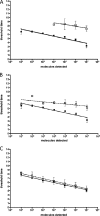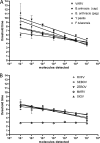Development of a panel of recombinase polymerase amplification assays for detection of biothreat agents
- PMID: 23345286
- PMCID: PMC3666764
- DOI: 10.1128/JCM.02704-12
Development of a panel of recombinase polymerase amplification assays for detection of biothreat agents
Abstract
Syndromic panels for infectious disease have been suggested to be of value in point-of-care diagnostics for developing countries and for biodefense. To test the performance of isothermal recombinase polymerase amplification (RPA) assays, we developed a panel of 10 RPAs for biothreat agents. The panel included RPAs for Francisella tularensis, Yersinia pestis, Bacillus anthracis, variola virus, and reverse transcriptase RPA (RT-RPA) assays for Rift Valley fever virus, Ebola virus, Sudan virus, and Marburg virus. Their analytical sensitivities ranged from 16 to 21 molecules detected (probit analysis) for the majority of RPA and RT-RPA assays. A magnetic bead-based total nucleic acid extraction method was combined with the RPAs and tested using inactivated whole organisms spiked into plasma. The RPA showed comparable sensitivities to real-time RCR assays in these extracts. The run times of the assays at 42°C ranged from 6 to 10 min, and they showed no cross-detection of any of the target genomes of the panel nor of the human genome. The RPAs therefore seem suitable for the implementation of syndromic panels onto microfluidic platforms.
Figures




Similar articles
-
Recombinase polymerase amplification assay for rapid detection of Rift Valley fever virus.J Clin Virol. 2012 Aug;54(4):308-12. doi: 10.1016/j.jcv.2012.05.006. Epub 2012 Jun 9. J Clin Virol. 2012. PMID: 22683006
-
Recombinase polymerase amplification assay for rapid detection of Francisella tularensis.J Clin Microbiol. 2012 Jul;50(7):2234-8. doi: 10.1128/JCM.06504-11. Epub 2012 Apr 18. J Clin Microbiol. 2012. PMID: 22518861 Free PMC article.
-
Isothermal DNA amplification combined with lateral flow dipsticks for detection of biothreat agents.Anal Biochem. 2018 Nov 1;560:60-66. doi: 10.1016/j.ab.2018.09.008. Epub 2018 Sep 11. Anal Biochem. 2018. PMID: 30217500
-
Current Trends in RNA Virus Detection via Nucleic Acid Isothermal Amplification-Based Platforms.Biosensors (Basel). 2024 Feb 11;14(2):97. doi: 10.3390/bios14020097. Biosensors (Basel). 2024. PMID: 38392016 Free PMC article. Review.
-
Advances in Virus Detection Techniques Based on Recombinant Polymerase Amplification.Molecules. 2024 Oct 21;29(20):4972. doi: 10.3390/molecules29204972. Molecules. 2024. PMID: 39459340 Free PMC article. Review.
Cited by
-
A Simple, Cost-Effective, and Extraction-Free Molecular Diagnostic Test for Sickle Cell Disease Using a Noninvasive Buccal Swab Specimen for a Limited-Resource Setting.Diagnostics (Basel). 2022 Jul 21;12(7):1765. doi: 10.3390/diagnostics12071765. Diagnostics (Basel). 2022. PMID: 35885667 Free PMC article.
-
Evaluation of molecular assays to detect Leishmania donovani in Phlebotomus argentipes fed on post-kala-azar dermal leishmaniasis patients.Parasit Vectors. 2021 Sep 9;14(1):465. doi: 10.1186/s13071-021-04961-6. Parasit Vectors. 2021. PMID: 34503557 Free PMC article.
-
A Novel Molecular Test to Diagnose Canine Visceral Leishmaniasis at the Point of Care.Am J Trop Med Hyg. 2015 Nov;93(5):970-5. doi: 10.4269/ajtmh.15-0145. Epub 2015 Aug 3. Am J Trop Med Hyg. 2015. PMID: 26240156 Free PMC article.
-
Development of Recombinase Polymerase Amplification Assays for Detection of Orientia tsutsugamushi or Rickettsia typhi.PLoS Negl Trop Dis. 2015 Jul 10;9(7):e0003884. doi: 10.1371/journal.pntd.0003884. eCollection 2015. PLoS Negl Trop Dis. 2015. PMID: 26161793 Free PMC article.
-
On-site and visual detection of sorghum mosaic virus and rice stripe mosaic virus based on reverse transcription-recombinase-aided amplification and CRISPR/Cas12a.Front Genome Ed. 2023 Jan 20;5:1124794. doi: 10.3389/fgeed.2023.1124794. eCollection 2023. Front Genome Ed. 2023. PMID: 36741944 Free PMC article.
References
-
- Peeling RW, Mabey D. 2010. Point-of-care tests for diagnosing infections in the developing world. Clin. Microbiol. Infect. 16:1062–1069 - PubMed
-
- Cuchacovich R. 2006. Clinical implications of the polymerase chain reaction: an update. Dis. Clin. N. Am. 20:735–758 - PubMed
-
- Carman B. 2001. Molecular techniques should now replace cell culture in diagnostic virology laboratories. Rev. Med. Virol. 11:347–349 - PubMed
Publication types
MeSH terms
Substances
LinkOut - more resources
Full Text Sources
Other Literature Sources
Molecular Biology Databases

